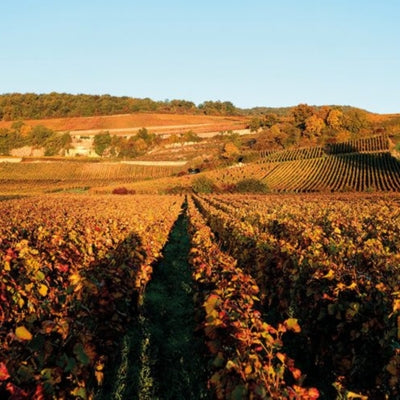
Discover Bonnes-Mares in six wines
The story of Bonnes-Mares could easily bear the title, “A Tale of Two Wines”, as wine connoisseurs famously love to dispute how this Grand Cru vineyard in Burgundy yields distinct dual profiles depending on from which part of its hallowed ground a red is crafted. Ranging from fleshly, fruity and round at one end of the site to elegant with pure berry notes and florals at the other, all its wines are, nonetheless, united by a slightly wild and individualistic character. Strong, defined, tannic structure lends itself to 30 to 50 years of cellaring, where this iconic Burgundy evolves complexity and subtlety.
Fast facts
Name: Likely, a nearby Cistercian monastery called Bonnes Meres ("good mothers"), the first founded for women in 1125, is the origin of its name.
Location: Bonnes-Mares encompasses 15 hectares on the Côte d'Or mid-slope in the Côte de Nuits sub-region. It’s bordered by the acclaimed Clos de Tart Grand Cru to its north, while its southern and western boundaries border Premier Cru vineyards, creating a rectangular shape between the Morey and Chambolle hillsides. Bonnes-Mares lies more in Chambolle-Musigny territory than that of Morey-Saint-Denis.
Climate and Soil: This Grand Cru is east-facing, lying between 250 and 280 meters in altitude on a gently sloping area. The soils are composed of reddish-brown gravel, limestone, white marl, clay, and flint. The Morey-Saint-Denis end has deep, rich soils that usually turn out full, masculine wines while reds produced from the Chambolle-Musigny neighborhood are typically light, silky, and fragrant. Both styles are well-structured, making them ideal for laying down.
Grapes: Pinot Noir is the vineyard’s varietal.
Appellation: Bonnes-Mares received Grand Cru status on December 8th, 1936.
Food pairing: The structure of Bonnes-Mares makes it an ideal partner for roasted game, wine-based or creamy sauces, and stews as well as strong cheeses like Époisses.
Fun fact: Bonnes-Mares is divided into around 20 plots. Napoleonic inheritance laws dictate equal division of land among heirs, so this quantity is set to increase over time, as will wine styles.
Indulge in the wines:
This family-run, third-generation house founded in the 1920s produces some of Burgundy’s most sought-after wines with Bonnes-Mares one of its crown jewel sites (it owns 1.6 hectares). Striving for terroir expression and with fruit sourced from six parcels, this Bonnes-Mares showcases the pronounced difference in soil types across the vineyard. Spicy with succulent dark cherry and subtle violet florals in a concentrated, full-bodied wine, this Burgundy garnered 96 points from Burghound and has the structure and depth to cellar for upwards of 50 years.
One of the locale’s legendary domaines, Domaine Comte Georges de Vogüé dates to 1450. The property has passed through generations of winemakers to the present-day Comtesse Gérard de Caussans and her sister, Marie de Vogüé. The house owns 2.6 hectares of Bonnes-Mares in the southwest part of the vineyard where low-yield vines are nourished by “terres rouges”. Fruit is treated to no more than one-third new oak so as not to mask the wine’s character. This Grand Cru, awarded 95 points by Burghound, displays ripe red and blue berry, spice, earthy hints, and a subtle brush of menthol in a powerful, muscular, almost rustic red that has decades of cellaring ahead of it.
Henri Boillot is a celebrated winemaker and négociant based in the Côte de Beaune that knows an excellent red wine vineyard when it sees it. As such, the house, which was founded at the start of the 20th century, produces Bonnes-Mares with Chambolle fruit under its négociant arm. Yields are low to promote quality and fruit is harvested late for maximum ripeness. The domaine vinifies all of its wines in its Meursault winery with partly-stemmed Pinot Noir fermented in stainless steel and barrel aged for 18 months in 50 – 70% new oak. Its benchmark, 95-point (Burghound) Bonnes-Mares displays pure red cherry, spice, currant, and earth lifted by violet and lavender in a juicy, muscular red with delicate salinity and good tension.
Lucien Le Moine is a Côte de Beaune boutique négociant house established in 1999 sourcing grapes from some of the region’s most prestigious vineyards with Bonnes-Mares one of its most illustrious sites. Winemaking is hands-on and meticulous with wines aged on lees, delayed malolactic fermentation for a softening effect, and 100% new oak. This Bonnes-Mares sees no blending, fining, or filtering and is bottled directly from the barrel. The result is a 97-point red (Burghound) with impressively broad yet flawlessly delineated fruity, spicy flavors in a focused, vibrant wine with considerable complexity.
From age-old domaines to new players, Olivier Bernstein made his first vintage in 2007, with names like Jancis Robinson and Allen Meadows putting him on the map with their praise. Transitioning from a career in entertainment management, Bernstein focuses on low yields and boutique production. A select cooper tastes each of his vintages and toasts barrels to the ideal level for each wine. His Bonnes-Mares, crafted from Chambolle fruit and one of six Grand Crus Bernstein works, displays an exceptionally complex, precise blend of concentrated dark fruit, appealing minerality, and the structure for extended aging. Burghound gave this vintage 95 points.
Our final Bonnes-Mares pick is from Domaine Bertheau, based in Chambolle-Musigny, and famed for its outstanding Grand Cru and Premier Cru holdings. Vines are, on average, 45 years old and thrive mostly on clay and limestone soils. Bertheau has a minimalistic approach, using little new oak for pure terroir expression and leaving the wines to develop gradually in barrel over 18 months. His Bonnes-Mares is from a third-of-a-hectare parcel in “terres rouges”, showcasing opulent red fruit, cassis, and plum liqueur with discreet oak and menthol hints in a supple, refreshing red with excellent aging potential.
Want to read more? Take a look at some of our other blogs here:
Also in News

Discover Mendoza in six wines

Hospices de Beaune auction 2025: Inside the world’s oldest charity wine auction
One of the most exciting events in the international wine calendar

